|
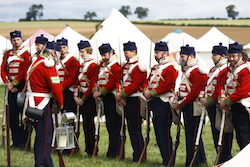
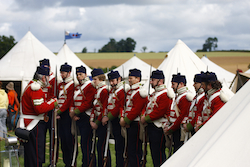
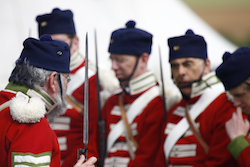
The 19th Foot
The 19th foot was raised in 1688 by Col. Francis Luttrell of
Dunster Castle Somerset. For service under William of Orange . They were dressed
in blue with orange facings, these colours being Luttrell’s livery.
 Their
service started in1689 as part of King Jame’s Army to land in Ireland. Where it
helped win the first pitched battle to be fought by the new British Standing
Army. This campaign continued until 1694. Their next service came in the
Marlborough Campaigns in the Low Counties, where in 1709 they fought at the
Battle of Malplaquet and all the main sieges during this campaign. The war of
Austrian Succession of 1745 followed where they fought at Fontenoy. The next
action campaign was during the Seven was during the Seven Years War where at the
French Island Fortress of Belle Isle where in 1761 their Grenadier Company
clawed its way up steep rocks & beat off 300 French men. Laying siege to the
fortress which fell after two months during the assault. The British forces lost
50% of its men. From here to American War of Independence late in 1781, they
were part of the Garrison at Charleston. After being stationed in Jamaica, it
was Flanders & Holland in 1794-5 during which the retreat of the Duke of York’s
army brought much suffering and hardship in the severest winter of the previous
century. Pushed by an enemy three times its strength . From 1796 to 1820 they
formed the back bone of the garrison in Ceylon. Their service broken only 4
times when they were sent to reinforce the armies in India. By the time the
Regiment left Ceylon in 1820 only two members who arrived in 1760 were left, 50
Officers and 1500 men has died mostly from tropical diseases contracted through
lack of hygiene & lack of medical knowledge. The next 34 years were peaceful
service when in early 1854 Britain and France found themselves allied in order
to counter Russia’s aggression against the Turkish Empire. Their
service started in1689 as part of King Jame’s Army to land in Ireland. Where it
helped win the first pitched battle to be fought by the new British Standing
Army. This campaign continued until 1694. Their next service came in the
Marlborough Campaigns in the Low Counties, where in 1709 they fought at the
Battle of Malplaquet and all the main sieges during this campaign. The war of
Austrian Succession of 1745 followed where they fought at Fontenoy. The next
action campaign was during the Seven was during the Seven Years War where at the
French Island Fortress of Belle Isle where in 1761 their Grenadier Company
clawed its way up steep rocks & beat off 300 French men. Laying siege to the
fortress which fell after two months during the assault. The British forces lost
50% of its men. From here to American War of Independence late in 1781, they
were part of the Garrison at Charleston. After being stationed in Jamaica, it
was Flanders & Holland in 1794-5 during which the retreat of the Duke of York’s
army brought much suffering and hardship in the severest winter of the previous
century. Pushed by an enemy three times its strength . From 1796 to 1820 they
formed the back bone of the garrison in Ceylon. Their service broken only 4
times when they were sent to reinforce the armies in India. By the time the
Regiment left Ceylon in 1820 only two members who arrived in 1760 were left, 50
Officers and 1500 men has died mostly from tropical diseases contracted through
lack of hygiene & lack of medical knowledge. The next 34 years were peaceful
service when in early 1854 Britain and France found themselves allied in order
to counter Russia’s aggression against the Turkish Empire.
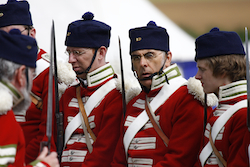 The
Regiment joined the allied armies at Scutari in order to defend Constantinople.
On 14th September they moved to Calamita Bay 27 miles from
Sebastopol. Four days later they marched to camp on the bank of the river Alma
where the Russian regiments were massed on the flat plateau opposite. The
Following day at 10 o’clock the battle started. After waiting 90 minutes for the
French attack to take effect, the British were told "the Infantry will advance"
they moved into the river and up the slope some 500 yards to the enemies guns.
As the men fired their new issued "Minie" Rifles they started to penetrate the 2nd
& 3rd ranks of Russian troops, part of the Regiment charged the
Artillery at a loss of half their men. Threatened by the precision of the
British fire the Russians started to withdraw towards Sebastopol, the British
continued to follow and capture the small harbour of Balaclava. The Regiment
lost 238 Officers & Men in this battle further contact came with the enemy in
October at Inkerman where the Regiment played a major part in the battle. A
winter in the trenches followed where many died of cold, disease & starvation.
Trench fighting followed in to the summer where two soldiers Samuel Evans an
John Lyon were awarded retrospectively two years later the new decoration of the
Victoria Cross. The
Regiment joined the allied armies at Scutari in order to defend Constantinople.
On 14th September they moved to Calamita Bay 27 miles from
Sebastopol. Four days later they marched to camp on the bank of the river Alma
where the Russian regiments were massed on the flat plateau opposite. The
Following day at 10 o’clock the battle started. After waiting 90 minutes for the
French attack to take effect, the British were told "the Infantry will advance"
they moved into the river and up the slope some 500 yards to the enemies guns.
As the men fired their new issued "Minie" Rifles they started to penetrate the 2nd
& 3rd ranks of Russian troops, part of the Regiment charged the
Artillery at a loss of half their men. Threatened by the precision of the
British fire the Russians started to withdraw towards Sebastopol, the British
continued to follow and capture the small harbour of Balaclava. The Regiment
lost 238 Officers & Men in this battle further contact came with the enemy in
October at Inkerman where the Regiment played a major part in the battle. A
winter in the trenches followed where many died of cold, disease & starvation.
Trench fighting followed in to the summer where two soldiers Samuel Evans an
John Lyon were awarded retrospectively two years later the new decoration of the
Victoria Cross.
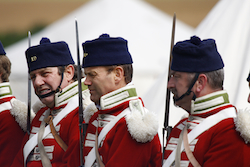 The
dress of the Regiment of this period was their full dress of a coatee, with grey
trousers & a pork pie hat, a wooden canteen on a brown strap for carrying of
water, with an ammunition bouch on a white belt over the right shoulder and a
haversack containing rations for 3 days, also a white cross belt with a bayonet
in its fob over the left. On the back was carried a large pack with a badge or
number on its centre. On its top was a "D" shaped mess tin and a rolled blanket. The
dress of the Regiment of this period was their full dress of a coatee, with grey
trousers & a pork pie hat, a wooden canteen on a brown strap for carrying of
water, with an ammunition bouch on a white belt over the right shoulder and a
haversack containing rations for 3 days, also a white cross belt with a bayonet
in its fob over the left. On the back was carried a large pack with a badge or
number on its centre. On its top was a "D" shaped mess tin and a rolled blanket.
information provided by D.P.&G Publications
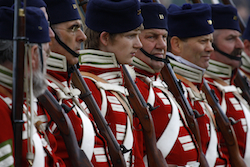

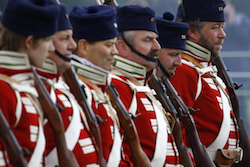
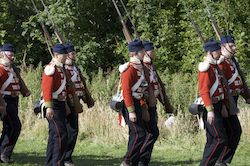
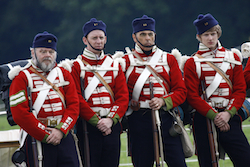

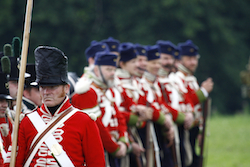
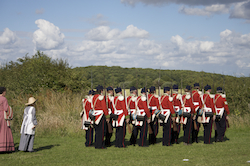
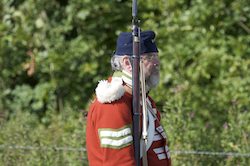
visit DP&G Publications site to purchase
books >>
|